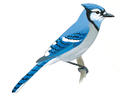 Birds use sophisticated changes to the structure of their feathers, not dyes and pigments, to create multi-colored plumage, and that is why they never go gray.
Birds use sophisticated changes to the structure of their feathers, not dyes and pigments, to create multi-colored plumage, and that is why they never go gray.
Using X-ray scattering at the ESRF facility in France to examine the blue and white feathers of the Blue Jay, researchers from the University of Sheffield found that birds demonstrate a surprising level of control and sophistication in producing colors - it is able to change the color of its feathers along the equivalent of a single human hair using a tunable nanostructure.
Instead of simply using dyes and pigments that would fade over time, the birds use well-controlled changes to the nanostructure to create their vividly colored feathers - which are possibly used for Jays to recognize one another. The Jay is able to pattern these different colours along an individual feather barb - the equivalent of having many different colors along a single human hair. The Jay's feather, which goes from ultra violet in color through to blue and into white, is made of a nanostructured spongy keratin material, exactly the same kind of material human hair and fingernails are made from.
The researchers found that the Jay is able to demonstrate amazing control over the size of the holes in this sponge-like structure and fix them at very particular sizes, determining the color that we see reflected from the feather. This is because when light hits the feather the size of these holes determines how the light is scattered and therefore the color that is reflected. As a result, larger holes mean a broader wavelength reflectance of light, which creates the color white. Conversely, a smaller, more compact structure, results in the color blue.
If the colors were formed using pigments created from the bird's diet, the feather color would fade over time. However, since nature has developed a way to create the colors through structural changes, any nanostructure will remain intact, explaining why birds never go gray as they age. In contrast, humans rely on pigments to color hair. As these are not produced to the same extent as we age, we consequently go gray.
Dr Andrew Parnell, from the University of Sheffield's Department of Physics and Astronomy said, "Conventional thought was that to control light using materials in this way we would need ultra precise and controlled structures with many different processing stages, but if nature can assemble this material 'on the wing', then we should be able to do it synthetically too.
"Current technology cannot make color with this level of control and precision - we still use dyes and pigments. Now we've learnt how nature accomplishes it, we can start to develop new materials such as clothes or paints using these nanostructuring approaches. It would potentially mean that if we created a red jumper using this method, it would retain its color and never fade in the wash."
Dr Adam Washington from the University of Sheffield added: "The research also answers the longstanding conundrum of why non-iridescent structural greens are rare in nature. This is because to create the colour green, a very complex and narrow wavelength is needed, something that is hard to produce by manipulating this tunable spongy structures. As a result, nature's way to get round this and create the color green - an obvious camouflage color - is to mix the structural blue like that of the Jay with a yellow pigment that absorbs some of the blue colour."





Comments